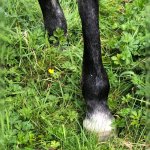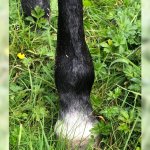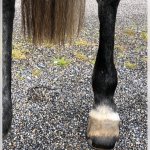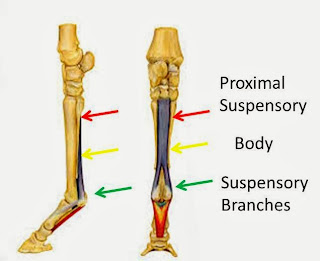brightlights
Well-Known Member
I took my sweet girl for a lesson on Monday and it seems she's sustained an injury. I am for sure fearing the worst, and have her booked in with our sports medicine vet as soon as they can see us, this coming Monday. I am following their care suggestions in the meantime.
I stupidly hoped she was just stocked up, as the swelling did seem to lessen with walking the following day. She wasn't visibly lame after the ride or the next day (off) either, though does seem to be slightly favoring that leg now.
The leg feels full and soft to the touch, with some warmness inside. No cuts or surface wounds. She'll lift it for me happily but doesn't love me pressing on it. Swelling is much reduced after wrapping but returns if wraps stay off. She is mostly standing square, occasionally rests it, and seems "normal" other than having a very puffy leg. She's on box rest now except a few steps out for hosing, but does not seem terribly uncomfortable on those steps. I have no experience with ligament or tendon injuries, but am fearing either suspensory branch or deep digital flexor. I have always been very careful with my horses and have also been very lucky/blessed (!) not to have had any soft tissue injuries before... so I don't have enough experience to know what I'm looking at. Does anyone here have any other possible guesses, since I'm fairly certain to be torturing myself until she's seen? I've read all about the path back from these tendon and ligament injuries, so I'm aware of all that and will cross that bridge Monday. Luckily we have a great vet...
I stupidly hoped she was just stocked up, as the swelling did seem to lessen with walking the following day. She wasn't visibly lame after the ride or the next day (off) either, though does seem to be slightly favoring that leg now.
The leg feels full and soft to the touch, with some warmness inside. No cuts or surface wounds. She'll lift it for me happily but doesn't love me pressing on it. Swelling is much reduced after wrapping but returns if wraps stay off. She is mostly standing square, occasionally rests it, and seems "normal" other than having a very puffy leg. She's on box rest now except a few steps out for hosing, but does not seem terribly uncomfortable on those steps. I have no experience with ligament or tendon injuries, but am fearing either suspensory branch or deep digital flexor. I have always been very careful with my horses and have also been very lucky/blessed (!) not to have had any soft tissue injuries before... so I don't have enough experience to know what I'm looking at. Does anyone here have any other possible guesses, since I'm fairly certain to be torturing myself until she's seen? I've read all about the path back from these tendon and ligament injuries, so I'm aware of all that and will cross that bridge Monday. Luckily we have a great vet...




